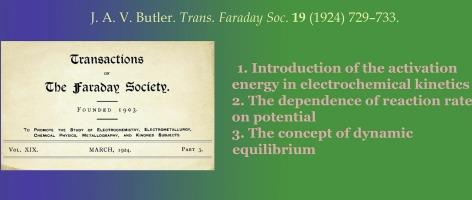1924年,巴特勒的模特
IF 4.1
3区 化学
Q1 CHEMISTRY, ANALYTICAL
引用次数: 0
摘要
1924年,巴特勒发表了一系列关于电化学平衡的论文,这成为电化学史上的一个里程碑。虽然这些文章的目标是平衡,但它们最终对电化学动力学产生了巨大的影响。具有讽刺意味的是,在从一般考虑写下他的动力学表达式时,巴特勒甚至没有费心去看这个领域的可用数据。这种对学术传统的违反似乎影响了巴特勒作品的接受。巴特勒的文章对同时代人的真正影响在今天很难评估。然而,从巴特勒到鲍登,再到沃尔默,再到Erdey-Grúz,我们可以追踪到这条影响链。这表明,他们的开创性作品无疑不仅受到鲍登的影响,也受到巴特勒的影响。巴特勒用许多新的方法丰富了电化学动力学,尽管在他的工作中动力学只是一个验证平衡的工具。他是第一个考虑到(尽管是以半定量的方式)势能对过程速率的影响的人。此外,正是巴特勒将动态平衡的概念引入了电化学动力学。为了更好地理解Butler引入的新概念,详细讨论了当时的电化学思想:扩散过程的Nernst- brunner模型,基于Nernst方程的Jahn-Schönrock概念,以及非电解质还原的Haber模型。本文章由计算机程序翻译,如有差异,请以英文原文为准。

1924 – The model of Butler
The year 1924, with the publication of Butler's series of papers on electrochemical equilibrium, became a milestone in the history of electrochemistry. Although the goal of these articles was equilibrium, they ultimately had a tremendous impact on electrochemical kinetics. It is ironic, but it seems that in writing down his kinetic expressions from general considerations, Butler did not even bother to look at the available data in this field. This violation of scholarly tradition seems to have affected the reception of Butler's work. The real impact of Butler's articles on his contemporaries is difficult to assess today. However, it is possible to trace the chain of influence from Butler through Bowden to Volmer and Erdey-Grúz. This suggests that they wrote their seminal work not only under the undoubted influence of Bowden but also of Butler.
Butler enriched electrochemical kinetics with a number of new approaches, although in his work kinetics was only a tool for validating equilibrium. He was the first to take into account, albeit in a semi-quantitative way, the effect of the potential on the rate of the process. Furthermore, it was Butler who introduced the concept of dynamic equilibrium into electrochemical kinetics.
In order to better understand the new concepts introduced by Butler, the electrochemical ideas of the time are discussed in detail: the Nernst-Brunner model of diffusion processes, the Jahn-Schönrock concept, based on the Nernst equation, and the Haber model of non-electrolyte reduction.
求助全文
通过发布文献求助,成功后即可免费获取论文全文。
去求助
来源期刊
CiteScore
7.80
自引率
6.70%
发文量
912
审稿时长
2.4 months
期刊介绍:
The Journal of Electroanalytical Chemistry is the foremost international journal devoted to the interdisciplinary subject of electrochemistry in all its aspects, theoretical as well as applied.
Electrochemistry is a wide ranging area that is in a state of continuous evolution. Rather than compiling a long list of topics covered by the Journal, the editors would like to draw particular attention to the key issues of novelty, topicality and quality. Papers should present new and interesting electrochemical science in a way that is accessible to the reader. The presentation and discussion should be at a level that is consistent with the international status of the Journal. Reports describing the application of well-established techniques to problems that are essentially technical will not be accepted. Similarly, papers that report observations but fail to provide adequate interpretation will be rejected by the Editors. Papers dealing with technical electrochemistry should be submitted to other specialist journals unless the authors can show that their work provides substantially new insights into electrochemical processes.

 求助内容:
求助内容: 应助结果提醒方式:
应助结果提醒方式:


